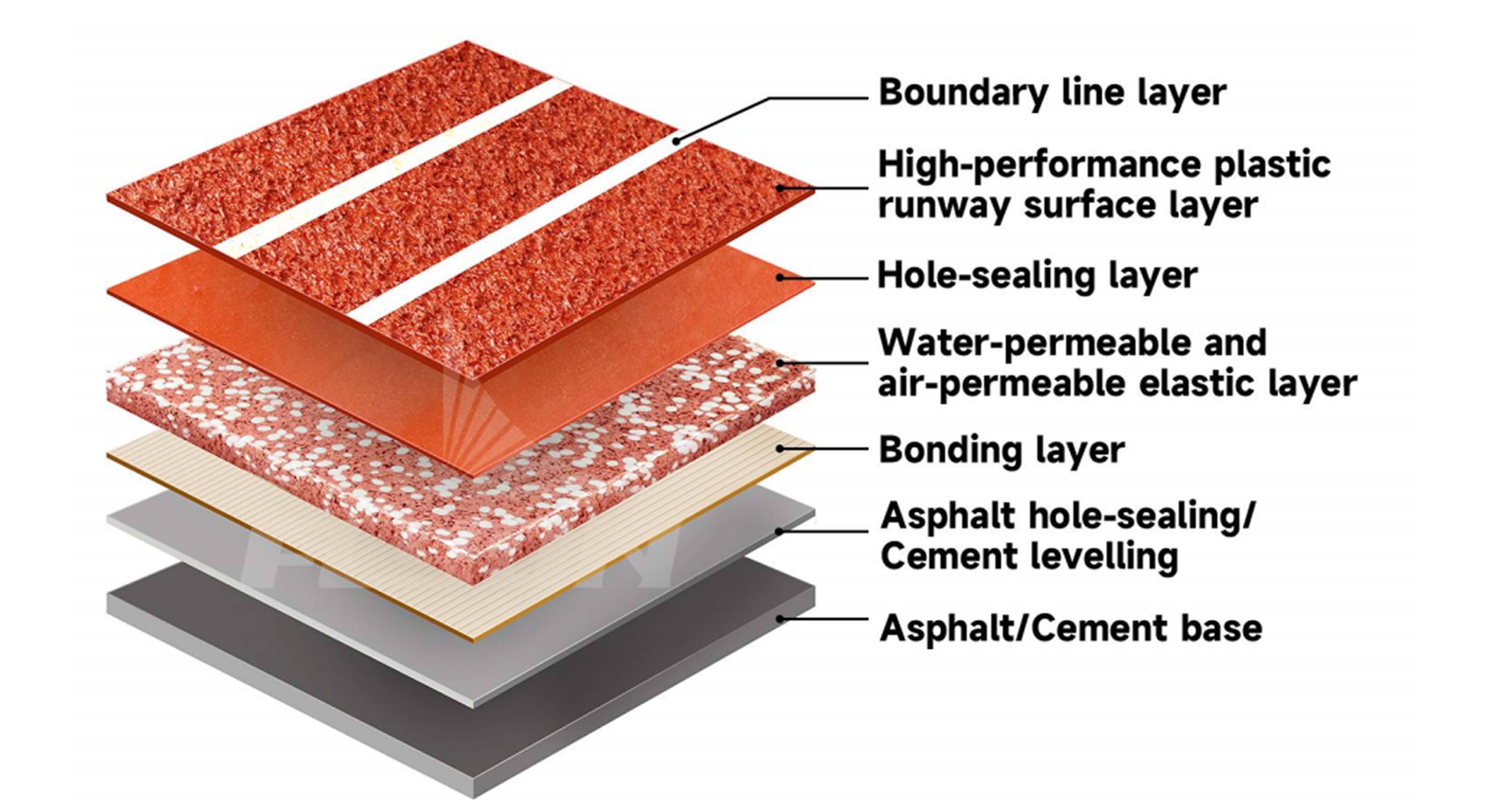Qəşəng Yarış Zolaqlarında Dayanıqlılığın Nə Qədər Önəmli Olduğu
Yüksək Hərəkətli Mühitlərdə Qəşəng Yarış Zolaqlarının Dayanıqlılığını Anlamaq
Yüksək intensivlikli idman tədbirləri bənzərsiz çətinliklərlə qarşılaşır: gündəlik istifadə idmançılar tərəfindən, müəyyən edilmiş tədbirlər və mövsümi hava dəyişiklikləri istismar sürətini artırır. Həftədə 500-dən çox istifadəçi dəstəyi göstərən qaçış zolaqları struktur bütövlüyünü orta intensivliyə nisbətən 40% daha sürətli itirir (ASTM International 2023). Bu deqradasiya təhlükəsizliyi pozur və istismar olunmuş zonaların sürüşməyə bağlı xəsarətlərini 18% artırır.
İstifadə tezliyinin dövrə səthinin bütövlüyünə təsiri
Daimi addımlar ənənəvi dövrələrdə bağlayıcı materialları zəiflədərək çatlar, qabarmalar və bərabərsizliklər yaradır. Meşələrdən və ya keçidlərdən fərqli olaraq, stasionar dövrələr dərələr və kəskin dayanışlarla istiqamətlənmiş gərginliyə dözürlər. 12 ay ərzində sintetik dövrənin təsirlərə dözümlülüyü ağır istifadə şəraitində 15% azalır və performans sabitliyini pozur.
Ənənəvi və müasir sintetik dövrə səthlərinin orta ömürlərinə dair məlumatlar
| Səthin növü | Orta Ömür (İl) | Hər kvadrat metr üçün İllik Təmir Xərcləri |
|---|---|---|
| Asfalt/Kül | 5–8 | $14–$18 |
| Poliuretanla Birləşdirilmiş | 12–15 | $7–$11 |
Beynəlxalq təkan sistemləri analizlərində qeyd edildiyi kimi, müasir sintetik materiallar dartılma testlərində ənənəvi variantlardan 3:1 üstün performans göstərir.
Tədqiqat nümunəsi: Kollej idman obyektlərində təkanın davamlılığı
İdman Elmləri Universiteti stendin iş funksiyasını 6-dan 14 ilə qaldırmaq üçün poliuretanla bağlı səthlərə keçdi. Quraşdırma sonrası məlumatlar səth təmirində 62% azalma və sprintsətirlərdə 22% artım göstərdi, çünki elastiklik dərəcəsi sabit qaldı.
Sintetik Təkan Səthləri: Davamlılıq və Performans üçün hazırlanmışdır
Sintetik təkan materiallarında və davamlılıqda irəliləyişlər
Ən yeni bərələr xüsusi polimerlərdən hazırlanır ki, bu da onların köhnə asfalt səthlərinə nisbətən 3-5 dəfə çox istifadəyə davam gətirməsinə imkan verir. Təxminən 2020-ci ildən etibarən istehsalçılar beynəlxalq idman mühəndisliyi jurnalında keçən il dərc olunan tədqiqatlar nəticəsində 8 uzun il ərzində belə təxminən 92% elastiklik xassəsini saxlayan xətti polimer formulalarından istifadə etməyə başlayıblar. Bu həqiqətən də ən böyük problem olan gündəlik dəfələrlə təkrarlanan qaçmaq və tullanmaq nəticəsində çatlayan ənənəvi bərələrin ən böyük problemi həll edir.
Poliuretanla bağlı bərə materialları: möhkəmlik və elastiklik birləşməsi
Qat-qat poliuretan sistemləri 13 mm şokudurucu bazanı 4 mm toxunmuş qaçış qatı ilə birləşdirərək aşağıdakı xassələrə malik səthlər yaradır:
- Uzunluğu 9 mm-ə qədər olan çıxıntıların deformasiyasına qarşı müqavimət göstərir
- Temperatur diapazonunda (-20°C-dən 55°C-ə qədər) elastiklik xassələrini sabit saxlayır
- Elit yarışlarda IAAF-nin 1-ci sinif sertifikatına nail olun
Materialın vizkoelastik xassələri enerjinin qaytarılması (orta hesabla 63%) və təsirin azaldılması (35% -ə qarşı rezin səthlərə nisbətən) eyni vaxtda təmin edir.
Sintetik rezin yarış zolaqları: yapışmaqla davamlılıq arasındakı tarazlığı təmin edir
Reciklə edilmiş rezin qranul səthlər aşağıdakı xüsusiyyətlərlə səmərəli alternativlər təqdim edir:
- mülayim iqlim zonasında 8–10 illik istifadə müddəti
- poliuretan sistemlərinə nisbətən 50% daha sürətli su drenajı
- Rəngin solmasını qarşısını alan ultrabənövşəyi sabit formulalar
Ancaq sərtlik testləri göstərir ki, 5 il ərzində səth sərtliyinin artımı poliuretan zolaqlara nisbətən 23% yüksəkdir.
Poliuretan və rezin zolaqların gərginlik testlərində müqayisəsi
| Metrik | Poliuretan Zolaqlar | Sintetik kauçuk trelər |
|---|---|---|
| Imlənməyə mukavimət | 9,2 tsikl/mm² | 6,8 tsikl/mm² |
| Təsirin zəiflədilməsi | 35–45% | 25–35% |
| İstilik Sabitliyi | ±0,5 mm genişlənmə | ±1,2 mm genişlənmə |
| İdarəetmə üsulu | 7 illik tsikllər | 5 illik tsikllər |
2024-cü il Dünya Atletika Səthi Sertifikasiya Proqramından alınan məlumatlar göstərir ki, poliuretan örtüklər rəqabət dərəcəsinin standartlarını saxlamaqla 15 illik ömrü ərzində 31% az təmir tələb edir.
Hava Şəraitinə Davamlılıq və Ətraf Mühitə Dözümlülük
Müasir stadda qaçış örtükləri struktur bütövlüyünü saxlayarkən müxtəlif hava şəraitinə dözümlü olan materiallardan hazırlanmalıdır. Ekstremal temperaturlar, yağıntılar və ultrabənövşəyi şüalar ənənəvi səthlərdə daha sürətli aşınmaya səbəb olur, lakin inkişaf etmiş sintetik sistemlər kimyəvi sabitliyi mexaniki möhkəmliklə birləşdirərək bu cür çətinliklərə qarşı durur.
Örtük Materiallarında Hava Şəraitinə Davamlılıq: Sintetik Örtüklər Necə Yağış, İstilik və Dona Dözümlü Olur
Poliuretan bağlayıcı maddələrlə hazırlanmış qaçış yolları suyu udmağı və temperatur dəyişsə belə sabit qalmağı təmin etdiyi üçün bütün hava şəraitində istifadə üçün ən yaxşı seçim halına gəlib. Adi asfalt və ya lateks ilə modifikasiya edilmiş asfaltlar isə nəmliyi saxlayır və ümumiyyətlə 3%-dən artıq mənimsəyir, buna görə də onlar rəqabət apara bilmir. Poliuretanın xüsusilə yaxşı tərəfi ondadır ki, tədqiqatlar göstərir ki, mənşəyində saxladığı elastiklik xassəsi -30 dərəcə Selsi soyuqluqda və ya 60 dərəcə Selsi istilikdə belə saxlanılır. Belə yollar qışda donma nəticəsində alt hissədən çatlamaz və isti yay günlərində də yumşamaz.
Rezin əsaslı sistemlərdə Hava Şəraitinə və Təbii Amillərə Müqavimət
İkinci dəfə istifadə olunan rezin yolların hazırlanmasında UIV və ozon təsirlərinə davamlılığı artırmaq üçün vulkanizasiya texnologiyasından istifadə olunur. Son nəsil tərkiblər əvvəlki nəsil rezin örtüklərlə müqayisədə 40% daha yavaş parçalanma göstərir və subtropik klimat şəraitində 5 il müddətində 85%-dən çox uzanma möhkəmliyini saxlayır. Bununla belə, onların poroz strukturu səbəbindən yağışlı iqlimlərdə daha tez-tez təmizlənməsi lazımdır ki, zibil toplanmasın.
Bütün hava şəraitinə davamlı yarış zolaqlarının təmir və tənzimlənməsi strategiyaları
Üç protokol hava şəraitinə davamlılığı artırır:
- Gündəlik : Zərrəcikli maddələrin təmizlənməsi üçün mexaniki sürtmə
- Mövsümi : Turş yağından yaranan kimyəvi eroziyanı qarşısını almaq üçün neytral pH təmizləyicilər
- İki dəfə illik : Təsirin güclü olduğu zonalarda dolğu materialının yenidən doldurulması
Bu tədbirləri həyata keçirən obyektlər reaktiv təmir yanaşmalarına nisbətən səth ömrünün 22% uzun olduğu barədə hesabat verir (Qlobal İdman İnfrasturkturu Hesabatı, 2023).
Trend Təhlili: Mülayim və tropik iqlimlərdə bütün hava şəraitinə davamlı qaçış zolaqlarının istifadəsinin yayılması
Tropik regionlər indi drenaj itkisiz monsun yağışlarını dəstəkləyə bilən poliuretan sistemləri sayəsində dünyada yeni sintetik pənahların 38%-ni təşkil edir. Əksinə, mülayim iqlim zonalarında qarışıq rezin-poliuretan örtüklərə olan tələbat artıq dona davamlılığı və il boyu traksiya təmin etdiyi üçün artıb – 2020-2023-cü illər arasında İsveçrədə və Kanadada quraşdırma işləri ilə 17% artıb.
Poliuretan örtüklərində Daşınmaya Qarşı Müqavimətin Elmi Əsasları
Poliuretan pənahların Kimyəvi Tərkibi və Davamlılıqdakı Rolü
Poliuretanın molekulyar tərkibi sərt izosiyanat hissələrini yumşaq poliol zəncirləri ilə qarışdırır və beləliklə təzyiqə davamlı, lakin yenidən formalaşma qabiliyyətinə malik olan material yaradır. Bu maddədən hazırlanmış stendlər hər il milyonlarla ayaq təzyiqinə davam gətirərək real aşınma əlamətləri göstərməzdən əvvəl möhkəmlik saxlayır, bu da 2023-cü ildə aparılan yoxlamalarla təsdiqlənmişdir. Polimer zəncirləri səthləri üzrə birləşərkən təzyiqi daha yaxşı paylayırlar, bu da stendin köhnə təbii kauçuklardan daha az sıxılması deməkdir. Bəzi yoxlamalar bu səthlərin ayaq altında əvvəlki kauçuk stendlərlə müqayisədə təxminən 40% daha az sıxıldığını göstərmişdir.
| Xüsusiyyət | Poliuretan Zolaqlar | Yaqrublu trekler |
|---|---|---|
| Gərmə Gücü | 25–50 MPa | 10–18 MPa |
| Imlənməyə mukavimət | 3,000+ Taber dövrləri | 800–1,200 dövr |
İdman səthləri üçün yüksək performanslı materiallar: Çarpaz birləşmə və elastiklik
İrəli manufacturing üsulları, 92%-dən artıq enerji qaytarma dərəcəsi ilə balanslaşdırılmış xətti sıxlığın optimal tənzimlənməsini təmin edir (Shore A 75–90). Polymer Elmləri Jurnalında (2023) dərc olunan tədqiqat göstərir ki, 85% xətti sıxlığa malik olan örtüklər temperaturlu iqlimlərdə 8 il istismar müddətində tutma əmsalını 1,3-dən yuxarı saxlayır.
Tədqiqat Nümunəsi: Avropa Stadionlarında Poliuretanla Birləşdirilmiş Örtük Materiallarından İstifadə
Avropa-nın 12 idman obyektinin 2019-cu il tədqiqatı göstərmişdir ki, poliuretan örtüklər 10 il sonra öz təsir udma qabiliyyətlərinin 94%-ni saxlayır, bu göstərici gücləndirilmiş rezin səthlər üçün 63% təşkil edir. Saxlanma xərcləri orta hesabla 1,2 ABŞ dolları/metr kvadrat ildə – asfalt alternativlərindən 38% aşağıdır.
Mübahisəli Tədqiqat: Ətraf Mühitə Təsirlərə Qarşı Performans Üstünlükləri
Poliuretan istehsalı təbii kauçuk emalından 22% artıq CO₂ yaratmasına baxmayaraq, yeni su bazalı poliuretan (WPU) formulaları uçucu üzvi birləşmələrin emissiyasını 70% azaldır. 2024-cü ilin Sürdürülebilirlik Hesabatında qeyd edildiyi kimi, WPU örtüklər hazırkı sistemlərlə müqayisədə eyni dərəcədə aşınmaya davamlılıq göstərir və eyni zamanda Avropa İttifaqının REACH kimyəvi təhlükəsizlik standartlarını ödəyir.
Ümumi Sahiblik Dəyəri: Təmir və Uzunmüddətli İnvestisiya
İşlədici örtüklərin ümumi sahiblik dəyərini (TCO) başa düşmək üçün əvvəldən quraşdırma xərcləri və cari təmir tələbləri hər ikisi nəzərdən keçirilməlidir. 2025-ci ilin Örtük Səthləri Araşdırmasına əsasən, düzgün təmir protokolları örtüklərin ömrünü təmir edilməmiş səthlərlə müqayisədə 40–60% artırmağa kömək edə bilər.
Örtük Səthinin Təmiri və Ömrünə Təsiri
İstismarın qarşısını almaq üçün hər gün süni örtüyün yuyulması və illik dərin təmizləmə ilə örtüyün uzun ömürlü saxlanması üçün tədbirlər görülülməlidir. Üç illik müşahidə tədqiqatında hər kvartalda səth yoxlaması keçirən təşkilatlar təmir xərclərini ildə orta hesabla 12 min ABŞ dolları qədər azaltmağı bacarmışdır.
Sintetik pərdələrin asfalt və ya gil pərdələrlə müqayisəli analizi: Təmir xərcləri
| Səthin növü | İllik təmir xərcləri* | İstifadə Müddəti (İl) |
|---|---|---|
| Müasir poliuretan | 3200 - 5800 ABŞ dolları | 8–12 |
| Asfalt | 8500 - 12000 ABŞ dolları | 3–5 |
| Xamir | 10000 - 15000 ABŞ dolları | 2–4 |
| *Xərclər 100m yarış zolağı üçün normallaşdırılmışdır (2025-ci il Yarış Zolaqları Səthi Araşdırması) |
Strategiya: Proaktiv qulluq vasitəsilə dövri xərclərin azaldılması
Planlaşdırılmış infraqırmızı taramalar səthin parçalanması görünməzdən əvvəl dərinlikdə sıxılma problemlərini aşkarlayır. Proqnozlaşdırıcı təmir modellərindən istifadə edən təşkilatlar ümumi mülkiyyət xərclərini ənənəvi reaktiv yanaşmalardan 22% azaltmışdır.
Sənaye paradoksu: Yüksək performanslı materiallar və uzunmüddətli xərc səmərəliliyi
İrəli getmiş polyuretan zolaqların asfalt alternativlərinə nisbətən 60% daha nadir səthin yenidən işlənilməsi tələb olunmasına baxmayaraq, onların daha yüksək başlanğıc xərcləri 43% kommunal operator üçün büdcə çətinlikləri yaradır. İlkin investisiya ilə dövri qənaət arasında bu gərginlik, dayanıqlı infrastruktur planlaması üçün ətraflı Ümumi Mülkiyyət Xərcləri (TCO) analizini vacib edir.
SSS
Sintetik zolaqların ənənəvi səthlərə nisbətən üstünlükləri nədir?
Sintetik zolaqların ömrü daha uzundur, yaxşı şok udma xüsusiyyətinə malikdir və asfalt və ya gil kimi ənənəvi səthlərlə müqayisədə təmir xərcləri daha azdır.
Sintetik meydançalar ekoloji və hava şəraitinə necə cavab verir?
Bu cür meydançalar hava şəraitinə davamlılıq üçün hazırlanmışdır, məsələn, poliuretan kimi materiallar suyu udmağa qarşı davamlıdır və temperatur dalğalanmaları zamanı struktur bütövlüyünü saxlayır.
Sintetik meydançaların saxlanması adətən istifadə olunan meydançalardan daha bahalı olurmu?
İlkin xərclər yüksək ola bilər, lakin sintetik meydançalar daha nadir saxlanma tələb edir və ömrü boyu illik xərclər daha aşağıdır, bu da onları uzun müddətdə sərfəli edir.
Sintetik meydançaların davamlılığına hansı amillər təsir edir?
Bu amillərə irəliləmiş polimer materiallardan istifadə, çarpaz rabitə sıxlığı və aşınma davamlılığını və təsirin zəiflədilməsini artırmağa kömək edən dizayn üsulları daxildir.
Sintetik meydançaların ətraf mühitə mənfi təsirləri varmı?
İstehsalı zamanı CO₂ emissiyaları daha yüksək ola bilər, lakin yeni formulalar zərərli emissiyaları azaldır və ciddi ekoloji standartlara cavab verir.
Mündəricat
- Qəşəng Yarış Zolaqlarında Dayanıqlılığın Nə Qədər Önəmli Olduğu
- Sintetik Təkan Səthləri: Davamlılıq və Performans üçün hazırlanmışdır
-
Hava Şəraitinə Davamlılıq və Ətraf Mühitə Dözümlülük
- Örtük Materiallarında Hava Şəraitinə Davamlılıq: Sintetik Örtüklər Necə Yağış, İstilik və Dona Dözümlü Olur
- Rezin əsaslı sistemlərdə Hava Şəraitinə və Təbii Amillərə Müqavimət
- Bütün hava şəraitinə davamlı yarış zolaqlarının təmir və tənzimlənməsi strategiyaları
- Trend Təhlili: Mülayim və tropik iqlimlərdə bütün hava şəraitinə davamlı qaçış zolaqlarının istifadəsinin yayılması
-
Poliuretan örtüklərində Daşınmaya Qarşı Müqavimətin Elmi Əsasları
- Poliuretan pənahların Kimyəvi Tərkibi və Davamlılıqdakı Rolü
- İdman səthləri üçün yüksək performanslı materiallar: Çarpaz birləşmə və elastiklik
- Tədqiqat Nümunəsi: Avropa Stadionlarında Poliuretanla Birləşdirilmiş Örtük Materiallarından İstifadə
- Mübahisəli Tədqiqat: Ətraf Mühitə Təsirlərə Qarşı Performans Üstünlükləri
- Ümumi Sahiblik Dəyəri: Təmir və Uzunmüddətli İnvestisiya
-
SSS
- Sintetik zolaqların ənənəvi səthlərə nisbətən üstünlükləri nədir?
- Sintetik meydançalar ekoloji və hava şəraitinə necə cavab verir?
- Sintetik meydançaların saxlanması adətən istifadə olunan meydançalardan daha bahalı olurmu?
- Sintetik meydançaların davamlılığına hansı amillər təsir edir?
- Sintetik meydançaların ətraf mühitə mənfi təsirləri varmı?
 EN
EN
 AR
AR
 FR
FR
 PT
PT
 RU
RU
 ES
ES
 BG
BG
 HR
HR
 CS
CS
 DA
DA
 NL
NL
 FI
FI
 DE
DE
 EL
EL
 HI
HI
 IT
IT
 JA
JA
 KO
KO
 NO
NO
 PL
PL
 RO
RO
 SV
SV
 CA
CA
 TL
TL
 ID
ID
 SR
SR
 SK
SK
 UK
UK
 VI
VI
 HU
HU
 TH
TH
 TR
TR
 MS
MS
 AZ
AZ
 KA
KA
 BN
BN
 LO
LO
 MN
MN
 MY
MY
 UZ
UZ


